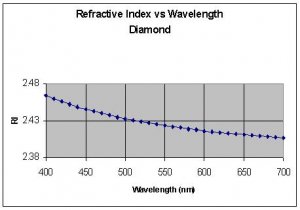Technical question and a re-write of a philosophical post I have had to edit due to forum policies.
1. How does diamond colour influence the refractive index of the diamond (assumed to be 2.417 or 2.418 depending on which way you round). e.g. D vs F or D vs K and white vs say yellow or pink.
2. Has anybody studied the 'cut' adjustments in relation to the crown and pav relationships compared to the Tolkowsky ideal of 14.5 / 40.75 degrees that are required if on was cutting a non-D coloured diamond of a fancy colour.
Diamonds are cut according to many factors including maximising profit from a rough's shape, inclusions, strain etc... and that there are many different proportions that have been studied and may still be lovely AGS0 type diamonds. The differences are also likely to be minute and insignificant So this is a purely philosophical question. It's fascinating stuff - perhaps I should give up my day-job, study gemmology, move to Melbourne and ask Cut-Nut for a job *wonders how much it pays*
So this is a purely philosophical question. It's fascinating stuff - perhaps I should give up my day-job, study gemmology, move to Melbourne and ask Cut-Nut for a job *wonders how much it pays*


Would I be right in assuming that the lower the refractive index, the shallower the combination should be and vice versa?
1. How does diamond colour influence the refractive index of the diamond (assumed to be 2.417 or 2.418 depending on which way you round). e.g. D vs F or D vs K and white vs say yellow or pink.
2. Has anybody studied the 'cut' adjustments in relation to the crown and pav relationships compared to the Tolkowsky ideal of 14.5 / 40.75 degrees that are required if on was cutting a non-D coloured diamond of a fancy colour.
Diamonds are cut according to many factors including maximising profit from a rough's shape, inclusions, strain etc... and that there are many different proportions that have been studied and may still be lovely AGS0 type diamonds. The differences are also likely to be minute and insignificant


Would I be right in assuming that the lower the refractive index, the shallower the combination should be and vice versa?













300x240.png)